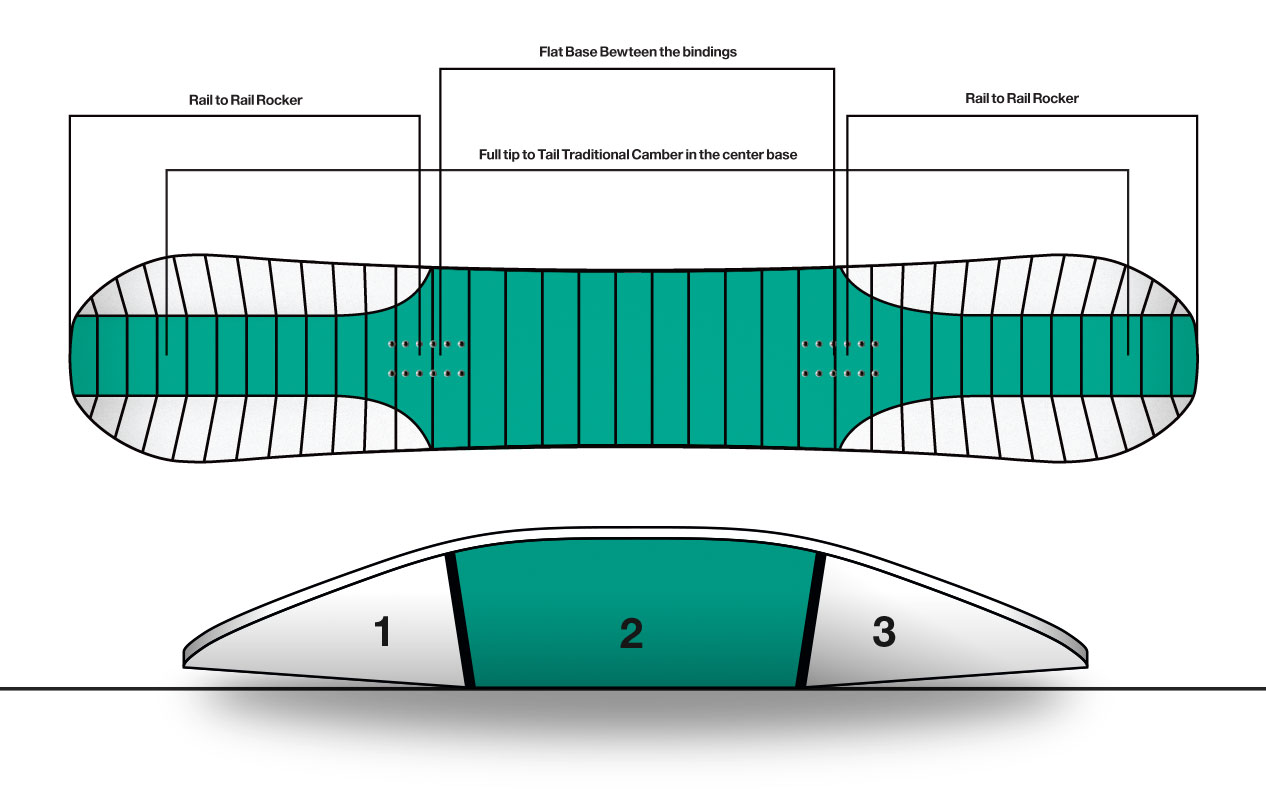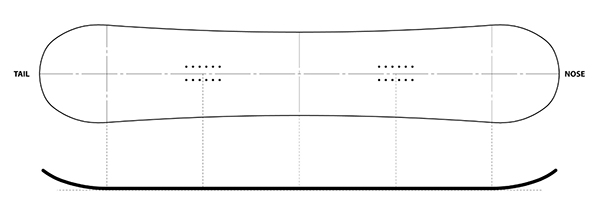SNOWBOARDS
The first snowboards, then called Snurfers, were made in 1929, as a children's toy. In the seventies, the famous brand Burton started making snowboards industrially. Nowadays, almost all big ski brands make snowboards and many big and smaller snowboard brands have specialised in making snowboards.
Almost all snowboards are made with a wooden core, underneath which is the battens. Most boards have holes with screw-thread, the so-called inserts. Only Burton has a second mounting system, where bindings are mounted on a kind of slot (EST bindings). Different manufacturers use different bindings with screws at different distances, but on modern boards, all these bindings can be mounted. Often, the discs have several holes in them and you can choose different mounting positions on the board. Depending on your height and stance on the board, you may be able to choose between different mounting positions.
Besides regular boards, there are also Wide snowboards. These boards are nothing less than boards for people with big feet. From size 44.5 up, you should often look for a Wide board. There are also Mid Wide boards, these are not made in a Wide version and can often accommodate shoe sizes up to about 45/46.
WHAT TYPE OF SNOWBOARD IS RIGHT FOR ME?
Are you looking for a snowboard, but do you have no idea what type of board suits you? Luckily, we can help you with that! In this video, our advisor Björn explains exactly which type of board suits which type of snowboarder. Snowboard are made in different categories.
If you start looking into the different types of snowboards, you'll notice that they can be divided into three categories: 'park/freestyle', 'all mountain' and 'freeride'. In this article, we will explain the differences between these categories.
Park/Freestyle
Park/Freestyle are the snowboards that are generally used for more freestyle-oriented riding. A trick, a bit of backwards, a lap in the park... With these boards you should be able to do it all! Park/freestyle boards generally have a more flexible character, which gives you the opportunity to make small mistakes during practice. Of course, these mistakes occur regularly when learning new tricks!
All-mountain
The second category are the all-mountain snowboards. The name says it all: with these boards you can cope with any conditions you may encounter on the mountain. All-mountain boards are therefore not only good to use on the piste, but also when you go off-piste or want to stunt in the park. These boards are stiffer than those in the freestyle category, because all-mountain snowboarding requires more speed and cornering. A more stable board is therefore more comfortable.
Freeride
The last category is the freeride category. In this category, the emphasis is mainly on turning. It does not matter whether you prefer to ride on the piste or off piste. With a freeride board, it's possible to go backwards a bit, but it won't be as easy as with a freestyle snowboard. Freeride boards are also stiffer than snowboards from other categories, because freeriding is often a lot faster and it's best to have a board with more stability. This way, these boards are much more stable when the speed goes up.
EVERYTHING ABOUT SNOWBOARD SHAPES
Rocker, camber... These terms are often used in the ski and snowboard world. No idea what they mean? On this page you can learn everything you need to know about the different snowboard shapes.
Twin vs. Directional
There are two main shapes in snowboarding. True twin and directional shapes. But there are also variations that are even more specific, like directional twin, asymmetrical twin, tapered directional. In this article we will stick to the basics, the true twin and directional shapes.
True twin shapes
These are snowboards that are often exactly symmetrical from front to back. The profile of the board (camber, rocker) is evenly distributed from front to back. This makes it easy to switch (backwards). The board is also symmetrical in terms of stiffness. Usually, your bindings are exactly in the middle on a true twin board. Of course, this type of snowboard is best used in the fun park or if you like freestyling. But there are also many all-mountain boards with a true twin shape, just because it's fun to switch every now and then.
Directional shapes
This type of snowboard is mainly designed to go straight ahead. In contrast to true twin shapes, directional shapes also tend to have a slightly more rearward slope. With a freeride stance, you will stand further back than with an all-mountain stance. The stiffness of the board often differs slightly at the front or back.
Camber vs. Rocker
Camber or rocker? What is the best choice for you?
Camber
The traditional shape for a snowboard as it has been used for many years, also called pre-tensioning. In a flat, unloaded position, only the tail and nose are in contact with the snow. The rider's load pushes the board flat and creates maximum tension from nose to tail. The ends of the board press down, the contact area is large. When turning in to the corner, a great deal of force is required to tip the board over. You have to push it through this tension, which only increases as the board tips over. There is immediately a lot of grip on the side. The camber shape is used in both directional and twin boards.
Characteristics of a camber shape:
- Lots of response
- Lively
- Good for heavier, more powerful riders
- Less room for mistakes
- Less floatation in loose or fresh snow
Rocker
The opposite shape to camber, the banana-like round shape. In a flat, unloaded position, the board is in contact with the snow only with a small area between the bindings. It is a bit like a banana. If you lay the board down, it can rock from nose to tail. The rider's load pushes the board flat and increases the contact area. There is less tension in the nose and tail compared to a camber. This tension is mainly present in the board, from binding to binding. This means that the board has less resistance during edge changes. You don't have to push it through the tension. The board actually already has the shape it will have when it is in the turn. This makes it easier to steer the board to the side. The disadvantage is that this also gives the board less grip on its side. There is less tension and less steel edge length to grip in the snow. The further you tip the board into the corner, the greater the grip. This is because there is more tension and steel edge length to cut with. This is because the board flexes more and more the further you lean into the bend. So there is less grip with a rocker shape than with a camber shape. The rocker shape is used on directional and twin boards.
Properties of the rocker shape:
- Very forgiving of mistakes
- Easy to change edges
- High floatation in loose or fresh snow
- Less grip when carving
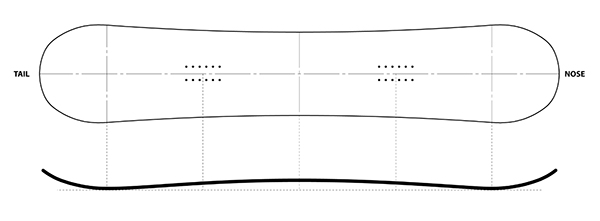

Hybrid Rocker
This is a combination of rocker and camber in one shape. It has 2 small cambers under the feet and a rocker in the middle. The rocker predominates in this profile. In a flat, unloaded position, the board is in contact with the snow in 1, 2 or 3 places; this depends on how deep the rocker comes down between the feet. With these hybrid shapes there is a difference from brand to brand as to how big the height difference is. On some boards the rocker is in the middle, lower than the tail and nose. With others, the tail and nose are the lowest point. Depending on these differences, one hybrid has more tension than the other. The more the shape resembles camber, the more tension is generated. The rider's load creates tension from just in front of, to just behind the binding. So less tension in the nose and tail than with a camber, but more than with a full rocker shape. They are lifted slightly off the ground, as it were. This gives the board an easy edge change, but it will grip faster than a rocker. With this shape, too, the maximum grip and steel edge length are present later in the turn than with a camber. But earlier than with a rocker. The hybrid twin shape is mostly used in twin shaped snowboards.
Features of a hybrid rocker shape:
- Forgiving
- Easy edge control
- Easy to float in loose and fresh snow
- Good grip when carving
Hybrid Camber
This shape is a combination of camber, from about foot to foot, ending in a "lifted" nose or tail. Sometimes also called rocker. Because this is also a combination of camber and rocker, we also call this a hybrid. In this profile, camber predominates. Camber can be in the middle, like in a twin. But it can also be more towards the back, like with directional profiles. Sometimes it is only under the old foot. In the unloaded position, the board is in contact with the snow at two points. These points are located just in front of and behind the bindings. The rider's load causes the board to flatten out almost completely, creating a large contact area. Only the nose and/or the tail come off the ground earlier, just after the bindings. They are 'lifted'. As a result, the widest part of the board, the nose and/or the tail, is not in contact with the snow. Because of the lesser tension in these areas, this shape steers to the side more easily than a full camber. There is also more buoyancy in loose and fresh snow. Because you do have your full steel side at your disposal early on in the turn, and there is tension from the camber, this board grips quickly. So the advantage of the buoyancy of the rocker and the response of the camber. This shape is found on both twin and directional boards.
Characteristics of a hybrid camber shape:
- Slightly gentler than camber
- Grippy
- Requires a little more power for changing edges
- Floats well in loose or fresh snow
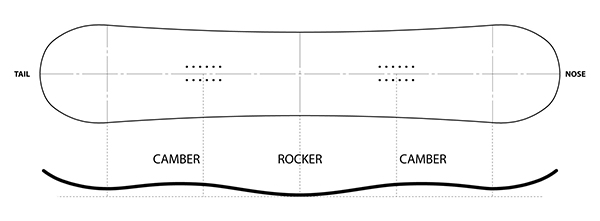
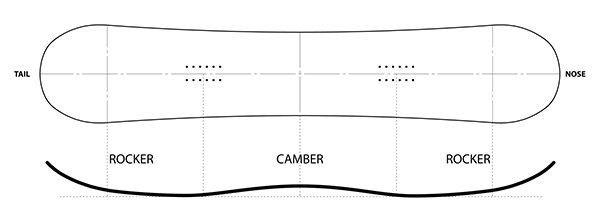
Triple Base Camber
The traditional shape for a snowboard, also called pre-tensioning. In a flat, unloaded position, only the tail and nose are in contact with the snow. The rider's load presses the board flat and creates maximum tension in the board from nose to tail. The ends of the board press downwards, which means that when the board is turned, it quickly grips the steel edge. By folding the outer contact points in the nose and tail upwards slightly, they are open. The shape looks a bit like a rounding in the nose and tail. This creates an easier steering phase than with full camber. There is less resistance because the board appears less wide. You roll a bit more from side to side. It looks a bit like the bow of a boat. When you turn in, you soon have the whole steel side available for grip. This grip is greater because the angle of the steel edge to the snow is more optimal compared to all other shapes. This shape is used in directional as well as twin shaped boards. Mainly by the Bataleon brand.
Properties of a camber Triple base shape:
- Great grip
- Easy edge control
- Good floatability
- Forgiving
- Easy to learn with
Flatbase Rocker
This shape has a flat zone under the bindings which ends in a rocker in the nose and tail. In the flat, unloaded position the board is in contact with the snow with its flat zone. The rider's load does not change the board's shape. The rocker zones mean that the nose and tail barely press into the snow at idle. There is less resistance when turning, which makes it easier than with camber. Because the entire steel side is available for grip early on in the turn, the board steers well. This is in contrast to a full, banana-shaped rocker. The tension created is not as direct as with camber or a hybrid. After all, you don't have to push a camber bulge out of the board. It is also slightly less lively, because there is less tension. This shape can be found in both twin and directional boards.
Characteristics of a Flatbase Rocker shape:
- Steers in easily
- Grippy
- Lots of room for error
- Slightly less lively
- Good floatability
